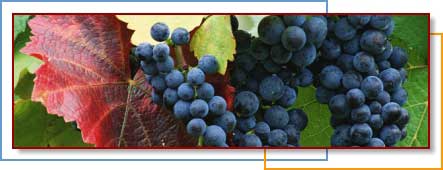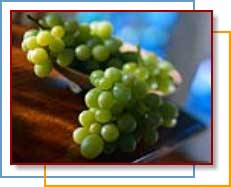
The grape is one of the oldest fruits to be cultivated going back as
far as biblical times. Spanish explorers introduced the fruit to America
approximately 300 years ago. Some of the most popular ways in which the
fruit is used, is eaten fresh, in preserves or canned in jellies, dried
into raisins, and crushed for juice or wine. Although, machines have taken
the place of much handwork, table grapes are still harvested by hand in
many places. (Wellness Encyclopedia of Food and Nutrition, 1992).
Grapes are about 80 percent water, making them a delectable low-calorie
snack or dessert; a cup of Concord or Catawba grapes contains only about
60 calories Grapes also add fiber to the diet and are naturally low in
sodium. Raisins, or dried grapes, contain only about 15 percent water. For
this reason, nutrients and calories are more concentrated in raisins-one
cup contains 464 calories! Like other dried fruit, raisins are a good
source of iron. Serving Size 1-1/2 cups (138g/14.9oz)
| |
| Grapes |
Serving
Size 1½ cup red or green grapes (80g)
| Amounts Per Serving |
% Daily
Value |
| Calories 60 |
|
| Calories
from Fat 0 |
|
| Total Fat
0g |
0% |
| Sodium 0mg |
0% |
| Total
Carbohydrate 14g |
5% |
|
Dietary Fiber 1g |
4% |
|
Sugars 12g |
|
| Protein 1g |
|
| Vitamin A |
2% |
| Vitamin C |
15% |
| Calcium |
0% |
| Iron |
2% |
* Percent Daily Values are based on a
2,000 calorie diet. |
|
| |
|
Grapes come in more than 50 varieties in black, blue, blue-black,
golden, red, green, purple, and white colors with a juicy pulp inside. The
two main types of grapes are the American and European. They both come in
seeded and seedless varieties. Common varieties include Thompson, Flame,
Ruby, Perlette and Tokay grapes. Most U.S. grapes are grown in California.
Look for firm, plump, well-colored clusters of grapes that are securely
attached to their green stems. Fully ripe grapes are soft and tender.
Grapes showing signs of decay, shriveling, stickiness, brown spots or dry
brittle stems should be avoided. Blue Concord grapes are excellent for
table use and for making juice and jelly. The large, purplish-red catawba
variety is used primarily for making juice and wine, but can also be
served fresh for eating.
Fresh Facts
- Fresh grapes maintain good quality for two to three days in the
refrigerator. Store in a covered container or plastic bag.
- Just before use, wash grape clusters under a gentle spray of water,
drain and pat dry.
- Table grapes are at their best served slightly chilled to enhance
their crisp texture and refreshing flavor.
- Seedless grapes are used whole. For seeded grapes, remove seeds by
cutting grapes into halves lengthwise and scooping out seeds with the
point of a knife.
- Grapes are easier to peel when they're frozen. Just rinse frozen
grapes in lukewarm water until skins split. Skins will then slip right
off.
- When preparing small clusters of grapes for garnishing, cut the
clusters with scissors. This helps keep the grapes attached to the
stem.
- For longer storage, grapes can be canned, frozen or made into juice
or sweet spreads to enhance meals throughout the year. Grapes can be
dried as raisins for use as a snack or in baking.
Canned
Facts
- Seedless grapes can be canned whole for use in fruit salads and
molded gelatin desserts. If seeded varieties are used, halve and
remove seeds before canning.
- To prevent mold growth, seal grape jelly with two-piece canning lids
and process for five minutes in a simmering water bath.
Freezer Facts
- Frozen grape juice is of excellent quality—serve it alone or mixed
with other juices. Freeze a few grape "popsicles" for an icy
summer treat.
- Freeze grape puree for use in making grape pie and to flavor
yogurt.
- Tray freeze seedless grapes and store them in freezer containers.
When summer temperatures sizzle, chill summer drinks with
"grape" ice cubes.
- For an easy, refreshing summer dessert, serve tray frozen grapes in
a chilled glass bowl.
Dried Facts
- The quality of dried grapes, or raisins, is excellent.
- For best results, use seedless grapes. If seeded varieties are used,
remove seeds as described under Fresh Facts before drying.
- In areas of high humidity, sun drying is not recommended. For best
results, dry grapes in a dehydrator or oven.
Recipes
 Grape and Napa Cabbage Stir-Fry Grape and Napa Cabbage Stir-Fry
Makes 4 servings.
Prep: Quick <20 min.
Ingredients
1 cup Onion, sliced vertically
1 Tbsp. Olive oil
4 cup Napa cabbage, cut into 1/2" slices
2 cup Halved seedless grapes
4 Dried shitake mushrooms, rehydrated and cut into ½" slices
2 Tbsp. Basil (fresh), chopped (2 tsp. dried basil may be substituted)
Salt and pepper to taste
¼ cup Water
1 tsp. Cornstarch
Sautè onion in oil until tender. Add cabbage, grapes, mushrooms,
basil, salt and pepper and stir-fry until cabbage is crisp-tender. Combine
water and cornstarch; mix well and add to grape mixture. Stir-fry about 1
minute or until sauce thickens.
Nutrition facts per serving: Calories 127, Fat 4 g (percent of calories
from fat: 27%), Cholesterol 0 mg, Fiber 2 g, Sodium 49 mg. Source: PBH/California
Table Grape Commission.
Find more in our
recipe database!
|



